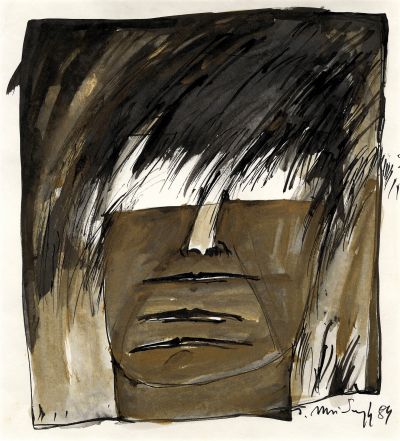Janina Musiałczyk. W drodze, on the road
Mediathek Sorted




































































































In 1978, when Janina Musiałczyk had been running the art group in the Palace of Youth (Pałac Młodzieży) for 11 years, they moved into a large apartment which they had bought themselves, in the newly constructed high-rise estate of Zgierska Stefana, in the Stare Bałuty district of Łódź on the northern edge of the city. “In my workroom”, she writes, “there is a huge loom. Above it, brightly coloured sheep’s wool, dyed in the bathtub. For hours, I weave tapestries with mallow flowers, trees, and landscapes. For sale. [...] Behind the window, huge high-rise apartment blocks. Windows lit up, rows of windows. A rhythmic composition. We sit on the floor on the small, round straw mat. Me and my closest students. We drink cocktails from high glasses. The time of long conversations”.[7]
Three years later, this period also came to an end. Under pressure from the political situation in Poland, the family left the country. On 27 May 1981, Musiałczyk writes, “we leave the apartment with three small suitcases and three umbrellas. Staszek, Zuzia and me”.[8] They first travelled to Malmö, where they spent two months living with acquaintances and with a Polish emigrant. From there, the journey continued to Hamburg, where they eventually arrived on 21 July 1981. A new odyssey began, which over the coming three months would take them to three hotels and a room in shared accommodation. Finally, at the beginning of October, they arrived in the high-rise estate in Hamburg-Steilshoop.
Two years later, in the spring of 1983, they remained on the same estate, but moved to a different building: “Fourth floor, three rooms, a balcony, carpeted floors left by the previous tenant, beige, dirty. The furniture in the bedroom also belonged to that tenant. A huge, white wall cabinet. [...] I hang drawings on the walls, an ever-increasing number of seeing stones”.[9]
At last, after an interim stop in Hamburg-Farmsen, the family found a permanent place to live in the autumn of 1987, in Hamburg-Volksdorf: “We paper the walls and paint them white. I hang up pictures. There are more and more of them. [...] In the spring, we eat breakfast on the balcony ... We invite guests, there is a mocha cake on the table [...] In my room, on the big wooden table, I draw the walks in black ink. On the wall, a photo drawing by Piotrek with the huge, black stone, Fijałkowski’s ‘Angel’ [...] I look out of the window, a rat scurries past along the fence. I call the local authority. ‘They are wandering rats, they move from one city to the next’”.[10]
Musiałczyk sets the indoor spaces of her life story on the right-hand side of her book opposite the external events, which take the form of a series of images created using graphics stamped with black ink. Hundreds of walking figures, hunched over, form at first orderly, then disintegrating, surging or marching masses, in more or less orderly rows or blurred groups, from which one or more figures charge out, fall over each other, stand alone in a circular centre, step out to the side of the multitude or move back into it. All the same, yet they are given a certain degree of personality through the differing application of colour, which initially has an intense depth, and which becomes paler as the stamping continues. The panels are part of the “Departure, Exodus” (Fortgang, Exodus) series created in 2000 (Fig. 45–48), which raises the artist’s personal experiences when leaving Poland to the general plane of forced flight. Having emerged from the mass of other people, the individual ultimately ends up in a battle against themselves (Fig. 49).
[7] Ibid., page 20.
[8] Ibid.
[9] Ibid., page 38.
[10] Ibid., page 42.





















































































